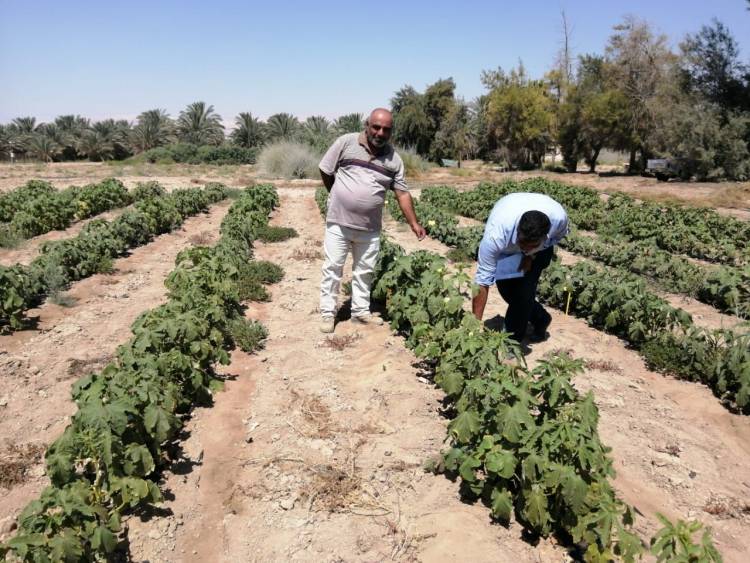"Salt is born of the purest parents: the sun and the sea," said once Pythagoras. Pure it may be, but too much of it in the soil can affect plant growth, a major problem for farmers, making the soil barren, threating agricultural production and food security.
The theme of this year's World Soil Day, celebrated on 5 December, - 'Halt Soil Salinisation, Boost Soil Productivity' - raises awareness about the fragile top layer of land that we all depend on for our food. Due to poor farming practices, climate change, sea water intrusion, land use changes and water seepage from dams, we are losing this precious natural resource at an alarming rate. Isotopic techniques are used in many countries to study the extent and causes of soil degradation, arming decisionmakers with the right data to protect it.
Globally, 932 million hectares of agricultural land - almost a fifth of the world's total - are affected by soil salinity, out of which 62 million hectares of soil are irrigated. Approximately 2,000 hectares per day of irrigated land in arid and semi-arid areas across 75 countries have been degraded by salinisation over the past 20 years. However, salinity is not only confined to arid and semi-arid regions. It can occur in any landscape, under any climatic condition. The most vulnerable regions include basins of the Aral Sea in Central Asia, the Indo-Ganges in India, the Indus in Pakistan, the Yellow River in China, the Euphrates in Syria and Iraq, the Murray-Darling in Australia and the San Joaquin Valley in the United States.
To avoid food shortages and meet increasing demand for a growing global population, estimated to rise to almost ten billion by 2050, agricultural production must increase by 60% globally and by 100% in some developing countries, according to the United Nations Food and Agriculture Organization (FAO).
Addressing Soil Salinisation
The IAEA, in collaboration with FAO, is working with countries that lose land to salinity on developing climate-smart agricultural practices to mitigate soil salinity and preserve agricultural land. The Joint FAO/IAEA Centre of Nuclear Techniques in Food and Agriculture has worked closely with institutions in 60 countries to find sustainable solutions for combatting soil salinisation. The Centre helps build capacity in a wide range of isotopic techniques to increase nutrient and water use efficiencies in the face of growing soil salinity and increase biological nitrogen (N) fixation through the capture of atmospheric nitrogen (N2) and carbon (C) stored in salt-affected soils.
Sixty researchers from ten countries were trained between 2014-2019 in soil, nutrient and water management to combat soil salinity. An open access book was published, containing protocols for salinity assessment, explaining the role of isotopic and other nuclear-related techniques to develop mitigation and adaptation measures for the sustainable usage of saline soils, including soils with high sodium content. By applying some of the best practices described in the book, experts in several countries have successfully grown crops with significant yields under saline conditions. These include millet in Lebanon, barley and safflower in Jordan and Kuwait, okra in Syria and quinoa in the United Arab Emirates.
"Thanks to the joint work with the IAEA, our scientists applied the recommended climate-smart agricultural practices to successfully grow crops under saline conditions," said Nabeel Bani Hani, Director of the National Agricultural Research Center in Jordan. "These practices were shown and disseminated to 45 local farmers who have incorporated them and are now happily growing barley in a saline region," added Bani Hani.

Okra grown under salt affected land in Jordan. (Photo: Nabeel Bani Hani / National Agricultural Research Center, Jordan)
Using saline irrigation water, these farmers are successfully growing barley with a grain yield of 2.5 tons per hectare - more than double of what they were able to achieve previously under rainfed conditions.
Experts from participating countries are exchanging data, technical information, agronomic practices and seeds for salt-tolerant crops to support each other.
Tackling Soil Salinity in Pakistan
Over a quarter of Pakistan's agricultural land is affected by salinity. However, the country's experts, in collaboration with the IAEA and the FAO, have developed different mitigation options to address this problem. These include the application of gypsum or acids to remove salts from the soil, of animal manure and chemical fertilisers to build up soil fertility, by using salt-tolerant crops, scrapping salts from surface soil and removing them through good irrigation water.
Excess fertilizer not taken up by plants contributes to increased soil salinity. Therefore, applying just the right amount of fertilizer is key. Scientists use nitrogen-15 (15N), a stable isotope of N, which helps to determine the exact amount of N crops need.
Another way in which nuclear techniques are used is in measuring the moisture content of the soil, so that the right amount of irrigation can be applied at the time the plants need it most. While conventional moisture sensors do not work properly under saline conditions, the soil moisture neutron probe functions well and is the most suitable sensor.
"Thanks to the collaboration with the IAEA, the problem of salinity in Pakistan was addressed by applying bio-saline agriculture technology which transformed the white face of our land into green," said Wajid Ishaque, Principal Scientist at the Nuclear Institute for Agriculture and Biology (NIAB) in Pakistan.

Animals grazing on salt-affected land in Pakistan. (Photo: M. Zaman/IAEA)






